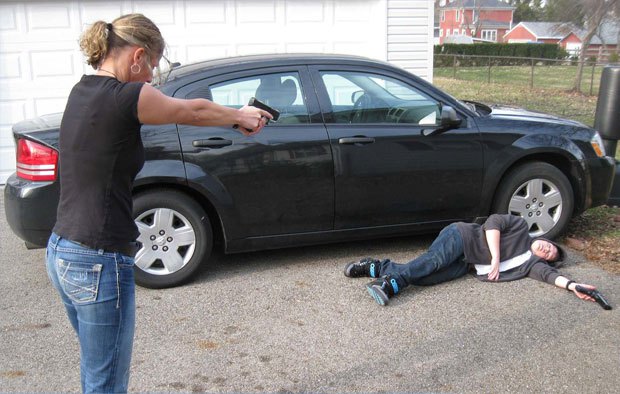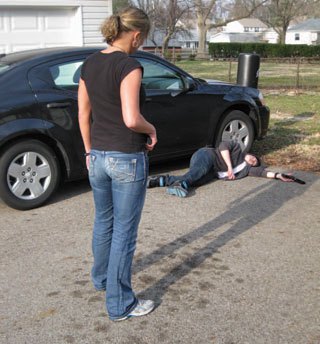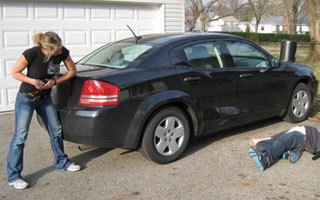In Colorado last week [June 22, 2021] an active killer shot a police officer and then began to fire his shotgun at other targets in the crowded downtown area. After running out of ammo, the killer then went to his vehicle and swapped his shotgun out for an AR-15 rifle and continued firing.
An armed citizen saw what was going on and intervened, shooting the cop killer. The armed citizen closed distance on the down active killer and removed the rifle from the killer’s hands. Other responding officers shot and killed the armed citizen, mistaking him for the active killer.
Read more about the incident at the linked articles below:
Hero who stopped Colorado gunman shot dead by police in case of mistaken identity

Here’s the statement from the local police chief:
“At 1:18 p.m., a call was received about a “suspicious person” in the Olde Town area by a teenager who said an older man made a noise and showed them a condom, police said. When Beesley arrived at the area, he parked in an alley and began walking. Troyke parked his truck in the same alley moments later.”
“The suspect got out of his truck with a 12 gauge semi-automatic shotgun, ran after Officer Beesley and yelled at him,” police said. “Officer Beesley stopped, turned and immediately was shot twice by the suspect. Officer Beesley did not reach for his gun and takes no defensive action – he simply turns in response to the suspect who then shoots and kills him.”
Troyke then shot out the windows of police patrol cars in the area and into the air, police said. He walked back to the truck and retrieved an AR-15, police said.
“The suspect ran back towards the Olde Town Square with the long gun, where he was confronted by Mr. Hurley,” the timeline said. “Mr. Hurley then shot the suspect with a handgun.”
“A responding Arvada Police Officer then encountered Mr. Hurley, who was holding the suspect’s AR-15,” police wrote. “The officer shot him.”
I’ve written about the danger of being shot by responding officers after intervening in an active killer attack many times, but I’ve never given precise guidelines about how to handle the post-shooting procedures in order to reduce the chance of being mistakenly killed. This article describes exactly what you should consider doing to keep from being killed by other first responders during an active killer attack.
- As you move to the scene, keep your gun holstered or hidden. Remember, you may not be the only person hunting the killer. Don’t confuse other CCW carriers, off duty cops, or uniformed officers. Put your hand on your holstered gun and draw when you are certain you can make a hit. Having the gun out before you can hit your target only places you in danger of being shot by another responder.
- After you shoot and the killer is neutralized, don’t keep pointing your gun at him. Draw your gun back into a compressed ready position. Hide it with your off hand. Better yet, holster your gun. Keep your hand on the gun if you think you may still need it, but you don’t want to be the guy pointing a gun around a pile of dead bodies when the cops arrive.

This is probably not how you want to appear to police officers responding to an active shooter scene.
- If you think you need to cover the downed killer with your pistol, the killer probably needs to be shot again. In an active killer situation, I’m going to shoot until the bad guy is no longer a threat.
If you shoot him and he goes down, but keeps trying to shoot other people or access his weapons, HE NEEDS TO BE SHOT SOME MORE. If he has already killed other people and is not obeying your commands to drop his weapon, HE NEEDS TO BE SHOT SOME MORE. Solve the problem. Make sure the killer is no longer a threat and then holster your pistol. - Consider how you look to responding officers. In order from most threatening to least threatening you could be:
-Aiming gun at the suspect
-At a low ready position
-At a high compressed ready (“chest ready”) or SUL position
-Gun holstered. Hand on gun.
-Gun holstered. Hands in the air.
-Gun on the ground. Hands in the air.
You’ll ultimately have to decide which is the best position to adopt depending on your analysis of how dangerous the suspect remains or the presence of additional suspects. Just realize that the higher up on the list you appear when the cops arrive, the greater the chance that you will be shot.

With her hand on her holstered pistol, this CCW permit carrier looks a lot less threatening to responding officers but she is still prepared to re-engage if necessary.

If you are afraid to holster the gun because further action seems imminent, bring the gun close to your body and cover it with the support hand. Get some cover as well.
I personally like the idea of holstering your gun. In a recent online discussion, my friend (and amazing shooter) Kirk Clark commented that knowing you can make fast and accurate first shots from the holster allows you the ability to keep the gun less visible and decreases your chance of being shot by responding police.
It’s comforting knowing that if the bad guy becomes animated again, you could shoot him with your holstered firearm in less than a second. If you have superior drawing/shooting skills you can afford to take the time to holster your weapon so as to appear less of a threat to responding cops.
What’s your draw to first hit time with your CCW holster? If it’s at or near two seconds or more, that may not be fast enough.
- Don’t approach the bad guy after you shoot. He may be playing dead, trying to lure you closer. He may have more than one gun. He my have explosives. There’s nothing to gain and a lot to lose by approaching the down suspect. Stay away from him and keep other bystanders away as well.
- Don’t secure bad guy’s gun unless it’s an imminent danger to other people or you need to leave the downed attacker to confront other killers. I can’t think of too many occasions where that would be likely. The rules for handling the bad guy’s gun are the same for handling your own weapon. Again, you don’t want to be the dude with a gun in his hand (no matter if it’s yours or his) standing over a bunch of dead bodies when the cops show up.There’s no need to secure the bad guy’s weapon if he is dead or unconscious. If he’s not dead or unconscious and is still handling the weapon, HE NEEDS TO BE SHOT SOME MORE. Shoot him again if he needs to be shot.
There are no tactical advantages for disarming the killer if he is truly incapacitated, yet your efforts to disarm him may be what gets you shot by responding cops. The juice isn’t worth the squeeze.
Think about this particular case. Our CCW rescuer dramatically increased his chances of being shot by the cops while he had a long gun in his hands. The responding cops don’t know that you are the good guy attempting to unload a murder weapon.
- Consider the “optics” of responding with a long gun. I regularly hear folks talking about getting their “truck gun” before intervening. Some folks carry folding stock AR-style “pistols” in sling bags while out in public. I don’t think that’s a very good idea.
While using a long gun gives you a tactical advantage as compared to responding using your concealed handgun, it also makes you much more likely to be shot by the cops. Even amped up and poorly trained cops know that there are lots of “good guys” packing CCW pistols. There are comparatively few CCW carriers who run around public areas with a long gun. Like it or not, long gun in public = “bad guy” in most cops’ brains. - Be ready for police. The cops are coming and they are coming in fast. Watch for them and be ready to be ordered to drop your gun and get down on the ground. Do exactly what the officer tells you to do. You’ll most likely be disarmed, handcuffed, and searched. Keep as calm as you can. Don’t argue, debate, or explain the facts to the responding cops. Just do what they say. You will be cuffed and treated like a criminal for a few minutes until the cops figure out what’s happening.If you are sure the killer is no longer a threat, it may be safer to place your gun on the ground instead of holstering it. After you take care of business, put your gun on the ground. Stand on it to keep it better secured. Get your hands up and be ready to follow the responding cops’ orders.
- Find a better position. After the shooting stops, look for a better position. Ideally, you want a position that provides you with cover from both the down bad guy AND from likely avenues of police response. Getting cover between you and the responding cops allows everyone a few more seconds to best evaluate the situation before acting.
- Manage the 911 call. If there are other people in the area, some of them will be on the phone with police. Instruct the callers to tell police that an armed CCW carrier is on the scene. Have the callers give dispatch a good description of you and the fact that you are NOT the suspect. Tell the caller to relay the fact that you are waiting for the cops and will comply with their orders when they arrive.
- If you have time, gather a “welcoming committee.” Gather one or more bystanders. Tell them what’s happening. Instruct them to find responding officers, provide your description and tell them that you are a “good guy.”The “welcoming committee” watches your back and informs police about what happened while you keep your eyes on the killer. If you can find someone who is willing to physically place his/her own body between you and the likely avenue of police approach in order to intercept responding cops, your chance of being shot by the cops is dramatically reduced.
As cops are arriving on scene, they are quickly trying to get “feel” for what’s going on. They are comparing what they see to what dispatch has told them is happening. They are quickly talking to people to find out where the suspect(s) and victim(s) are. Doing all this while knowing you might be the next victim, makes many elements of this response sequence overwhelming for the responding cops.
The cops are operating on limited information and an intuition about what is happening. They are primarily looking for suspects. It’s in your best interest to not look like one. Don’t stand there with a gun in hand.
Look like a “helper” instead. Do what you can to provide assistance. Instruct people to call 911. Keep people away from the bad guy. Move people to cover. Get people away from potential threats. Start providing medical care to the injured. Looking like a “helper” and not looking like a “suspect” is what will minimize the chances of your being shot by either responding officers or another CCW carrier.
In a horrible event like an active killer scene, your gun will seem like the most important piece of life saving equipment you can hold on to. It is exactly that, until the cops arrive. At some point in the engagement, the gun will do more to put you in danger than it will to protect you against the killer(s). Recognize that fact and don’t be seen standing over a pile of dead bodies with your pistol out and at the ready.

